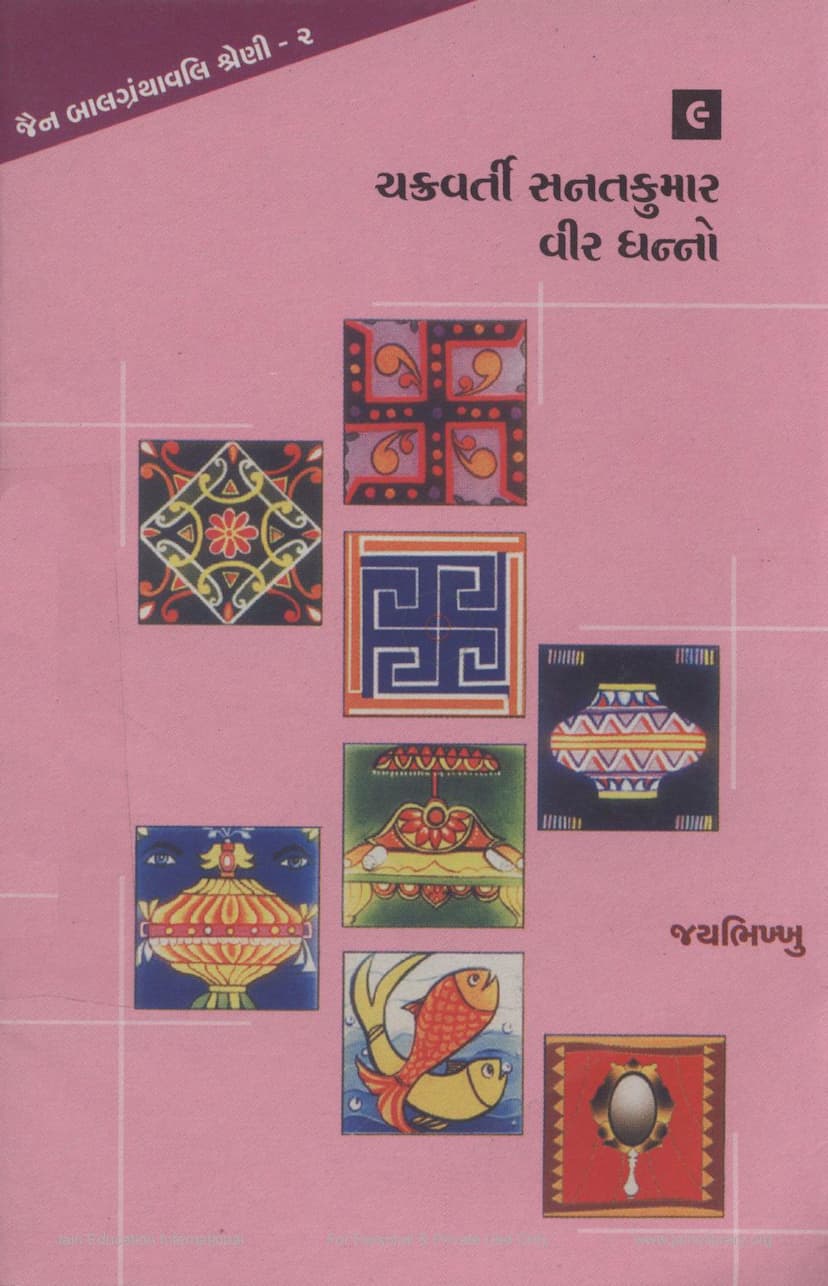Chakravarti Sanatkumar Vir Dhanno
Added to library: September 1, 2025

Summary
This document summarizes the Jain text "Chakravarti Sanatkumar Vir Dhanno" by Jaybhikkhu, published by Jaybhikkhu Sahitya Trust. It is part of the "Jain Balgranthavali Shreni-2" series, aimed at children and young readers.
The book tells the story of two prominent Jain figures: Chakravarti Sanatkumar and Vir Dhanno.
Part 1: Chakravarti Sanatkumar
The story begins with King Ashvasena of Hastinapur and his queen Sahadevi. Queen Sahadevi has auspicious dreams, interpreted by scholars to mean she will have a son who will be either a Chakravarti (universal emperor) or a Tirthankar (spiritual leader). She gives birth to a son named Sanatkumar, who is exceptionally beautiful and radiant. Sanatkumar is well-educated and grows up with his friend Mahendra.
During the spring festival, Sanatkumar goes to an orchard with his friends. A merchant brings a horse for sale. Sanatkumar mounts the horse, which, instead of obeying, gallops away with him into a dense forest. His friends and father are worried. The merchant suggests the horse might be divine, possibly belonging to Vidyadharas (celestial beings) who may have taken Sanatkumar.
Mahendra, determined to find his friend, ventures into the dangerous forest alone after the king and others turn back. He faces numerous perils: man-eating insects, carnivorous birds, and even a horse-devouring insect. He travels through treacherous terrain, encounters wild animals like cheetahs and lions, and survives by drinking water from streams and eating fruits. After a year of searching, exhausted and in torn clothes, he hears the sounds of birds and music near a lake. He finds Sanatkumar surrounded by beautiful women and Vidyadharas.
Sanatkumar explains his story to Mahendra. He was carried away by a magical horse, brought to a city of Vidyadharas, and married eight daughters of King Bhanuveg. Later, a defeated Yaksha abducted him and abandoned him in the forest. He then encountered a woman, Sunanda, who was about to commit suicide for him. He saved her and married her.
Mahendra and Sanatkumar return to Hastinapur, where Sanatkumar is crowned king. He conquers many lands, becoming a Chakravarti. His reign is marked by immense wealth and beauty.
One day, two celestial beings visit Earth disguised as Brahmins to witness Sanatkumar's renowned beauty. Impressed by his appearance and prosperity, they are still struck by the ephemeral nature of worldly possessions and beauty. They explain to Sanatkumar that all these things are temporary and will eventually decay. This realization leads Sanatkumar to renounce worldly life. He takes diksha (becomes a monk) and practices severe penance, even enduring seven diseases caused by his austere diet.
Two physicians visit him and offer to cure his physical ailments. Sanatkumar asks if they can cure the spiritual diseases of the soul. Upon realizing his spiritual prowess, they reveal themselves as celestial beings and disappear. After years of rigorous penance, Sanatkumar attains liberation, having demonstrated the importance of detachment and spiritual pursuit over worldly glory.
Part 2: Vir Dhanno
The second part of the book introduces Dhanno, the youngest son of Seth Dhansar. Dhanno is intelligent, sharp-witted, and blessed with good fortune. His father dotes on him, which causes jealousy among his elder brothers.
To test his sons, Seth Dhansar gives them gold coins and asks them to trade and earn money. Dhanno, using his cleverness, overhears a conversation about a caravan carrying valuable spices and makes a profitable deal. His brothers, however, engage in trivial trade, making little profit. This success further fuels their envy.
In another test, Seth Dhansar gives them gold coins again. Dhanno buys a ram and wins a bet with the prince by making the ram win a fight, earning him a golden mohar. His brothers fail to earn anything significant, accusing Dhanno of gambling.
In a third test, Dhanno buys a discarded bed with hidden jewels, while his brothers return empty-handed. Their envy continues to grow.
The brothers become so envious that they demand their share of the property and accuse Dhanno of theft. Dhanno, seeking peace, decides to leave home.
He travels to Rajagriha and stays in a dry garden, which miraculously becomes lush and green. The owner, impressed, gives him his daughter in marriage. Dhanno prospers and becomes a wealthy merchant. He tames a wild elephant, earning the king's favor and another daughter in marriage. He also resolves a legal dispute concerning a stolen eye, further enhancing his reputation.
Dhanno's family, who had fallen into poverty after his departure, are found to be working as laborers. He brings them back and supports them. His brothers, still envious, accuse him of stealing jewels.
Dhanno then travels to Kaushambi and participates in a gem identification competition. He identifies a gem correctly, earning royal recognition. He founds a city called Dhanpur but faces a water shortage. While overseeing the construction of a lake, he discovers his impoverished family working as laborers. He reunites with them and takes care of them.
Dhanno marries four more women from wealthy families, bringing his total number of wives to eight.
One day, his wife Subhadra mentions her brother Shalibhadra's renunciation of worldly life, where he abandons his wives one by one. Dhanno, considering this a weak form of renunciation, decides to renounce his own worldly life with all his eight wives. He challenges Shalibhadra, and both, along with Dhanno's wives, take diksha from Lord Mahavir and practice severe austerities. They lead a life of immense tapas (penance) and achieve spiritual liberation.
The book concludes by praising the virtues of Dhanno and Shalibhadra and wishing well-being to all. It also includes two parables from Lord Mahavir's teachings: one about losing a fortune over a small coin, emphasizing the importance of valuing what one has, and another about two tortoises, highlighting the benefits of self-control and detachment in the face of worldly temptations.